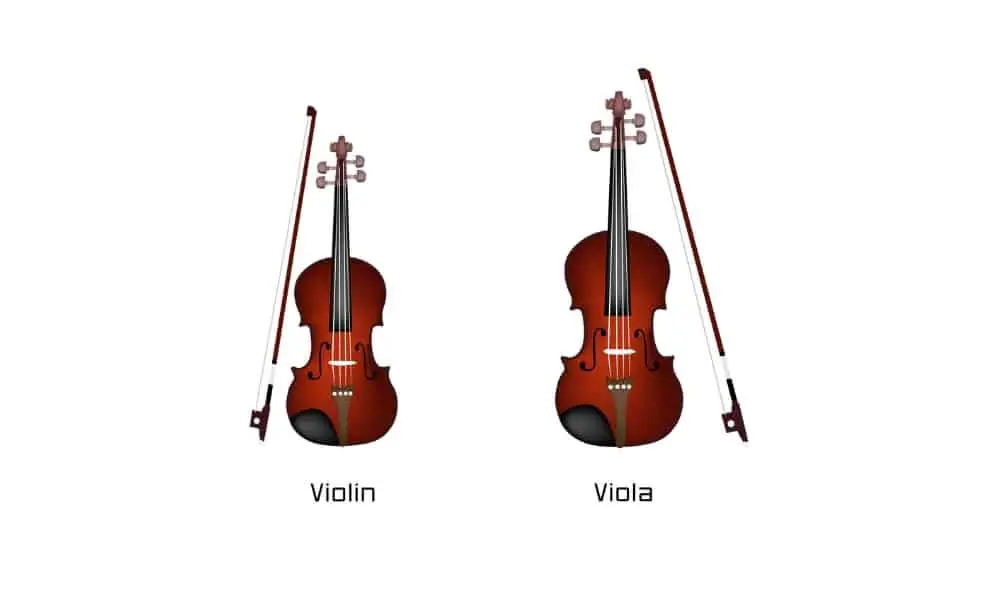You may be thinking about saving money by using one bow for both your violin and your viola. Although the temptation to use a single bow is understandable, there are a few facts you should consider before doing this.
Below we’ll dig into the differences between the two instrument bows.
Table of Contents
Are Violin and Viola Bows The Same
Violin bows and viola bows are not the same. Because violin strings weigh less than viola strings, a different bow is recommended for each instrument. Using a bow specifically designed for the instrument will insure that you’re able to achieve the desired tones and sounds.
There are differences in the bows in the following categories:
- Weight;
- Length;
- Amount of hair;
- Frog shape; and
- Stiffness
(See more on theses differences below)

How To Tell A Viola Bow From A Violin Bow
Violin and viola bows are very similar in appearance; however, there are some significant differences that are outlined more thoroughly below. Every bow shares these design elements:
- The stick. The stick is a long piece of wood that is either circular or octagonal in shape.
- Horsehair ribbon. This ribbon is white hair from the tail of a horse that strokes the strings to create sound.
- A frog. The frog is the area on the bow you hold when playing. The frog forms the end of the bow, housing the screw and eyelet mechanism which is used to tighten and loosen the horsehair.
- A ferrule. The ferrule is a metal band that surrounds the frog where the horsehair is attached. The purpose of the ferrule is to keep the horsehair evenly aligned for a consistent sound.
- A screw. The screw is the mechanism used to tighten and loosen the horsehair.
- The tip. The tip is the top end of the bow.
Now for the differences between the violin and viola bows.
Length: The violin bow is slightly longer than the viola bow. The average length of an adult-sized viola bow is 29 inches; whereas, the average length of the violin bow is 29.5 inches.
Weight: Viola bows weigh more than violin bows. The violin bow is about 10 grams lighter than the viola bow. The average weight of a violin bow is 60 grams; while the average weight of a viola bow is 70 grams.
Amount of hair: Viola bows use more hairs than violin bows because the band of horsehair on the viola is wider than the band on the violin. Violin bows are made with approximately 150 horse hairs; while viola bows have about 175 hairs.
Frog shape: Violin bows have frogs with straight edges. Viola bow frogs are chunkier and curved most times.
Stiffness: The viola bow is stiffer which makes it more difficult to use with fast strokes often made when playing the violin.
The Differences In Violin Bows and Viola Bows
This checklist gives a quick overview of the main differences between the violin bow and the viola bow.
| Violin | Viola | |
| Length | 29.5″ | 29″ |
| Weight | 60 grams | 70 grams |
| Hair | 150 hairs | 175 hairs |
| Frog | straight edge | curved |
| Stiffness | more flexible | stiffer |
Why Are Different Bows Needed for Violins vs. Violas
The bow used for a string instrument is crucial to achieving the sound of the instrument. For example, to achieve a smoother, fuller sound, a suppler bow is used; while a stiff, strong bow will give you a focused and light sound.
Since the sound sought from a violin is different than that desired from a viola, a different bow is needed.
A longer bow is needed for violins primarily because of the techniques used to play the violin. The higher-pitched violin is played faster than the viola. In order to hold longer notes without returning the bow, you must use a bow longer than the viola bow.
To produce a smooth sound, the lower pitch viola requires the bow to be heavier than a violin bow.
Is It Okay To Use a Viola Bow On a Violin
Is not recommended that you use a viola bow on a violin. Playing with the wrong type of bow can damage your violin. The strings of a viola are heavier and need a bow with more weight. A violin should not need the weight of a viola bow to produce a great sound.
13 Tips For How To Choose The Best Bow For Your Instrument
What is considered the perfect bow is subjective, determined by each individual musician. Beginners will need different attributes than those needed by an experienced or professional player.
As a beginner, you’re looking for a good string bow, good chamber curve, good weight, proper balance, and a comfortable grip.
Your needs for a bow changes with your level of experience because the type of music you’re playing will change. Here are a few tips to help you find the right bow at whatever level you’re playing.
Tips:
- The price of bows range from $20 for cheaper, brazilwood bows up to several thousand dollars for the most expensive Pernambuco bows. You should establish a budget for your purchase before you start shopping.
- It is best to handle the bow and play with the bow to observe the weight, balance, and sound before making your purchase.
- Buy your violin first- before you buy your bow.
- Try out bows using your own instrument. You will need to know how the bow sounds on your instrument.
- Try out several bows before making your final purchase. The more bows you can try, the better decision you will make.
- When trying the bows, play a variety of techniques to see if the bow is responsive.
- When examining the chamber curve, the center of the curve should be in the center of the bow to appreciate proper balance.
- The bow should feel natural and comfortable in your hand.
- When judging the sound of the instrument, don’t listen to the sound under your ear, listen to the sound in the room.
- It can be helpful to take an instructor or someone knowledgeable about string instruments with you to give their opinion about the sound.
- Play pieces you are familiar with when testing the bow. If you’re comfortable with the piece you’re playing, you will know how if should sound and how you usually feel playing it. You won’t have to question whether the bow is causing issues with how you’re playing and how the song sounds.
- A bow’s balance is more important than its weight. Bows should be well balanced from tip to frog with equal weight throughout.
- Wood bows are affected by climate, expanding and contracting based on humidity. Consider buying a composite (carbon fiber) bow if you live somewhere with extreme climate changes throughout the year.
Watch while this violinist chooses a bow from a group of 30 bows. He details what he’s looking for in a bow as he plays with each bow.
Sources
https://stringsmagazine.com/a-guide-to-buying-a-bow/
Violins for Dummies, 3rd Ed. by Katharine Rapoport (2020)
